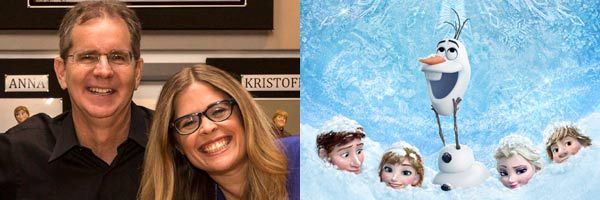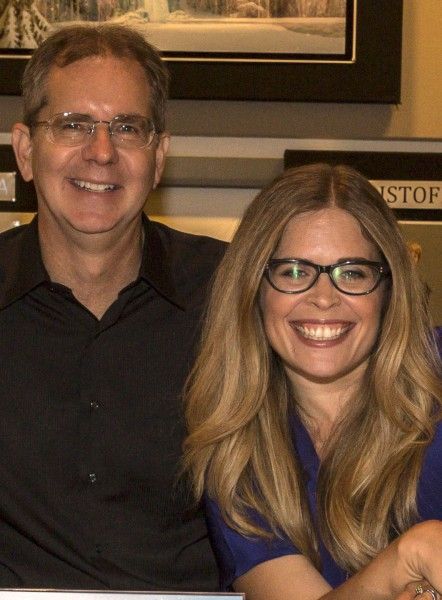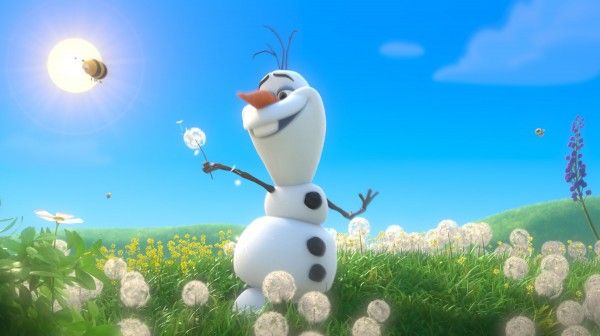To promote the upcoming November 27th release of the Disney animated feature Frozen, the studio invited members of the press out to see about 30 minutes of the film, which included the original song “Let it Go,” featuring the powerhouse vocals of Idina Menzel. The comedy-adventure follows fearless optimist Anna (voiced by Kristen Bell), who sets off on an epic journey to find her sister, meeting rugged mountain man Kristoff (voiced by Jonathan Groff) and his loyal reindeer Sven along the way. Elsa (voiced by Menzel) has used her icy powers to trap Arendelle in eternal winter, and Anna and her new friends must battle the elements in a race to save the kingdom.
The glimpses we got of the film were both stunningly beautiful and hugely expansive, having been visually inspired by a trip some of the creative team took to Norway. While at the press day, Collider got the opportunity to do this exclusive interview with co-directors Chris Buck (Tarzan, Surf’s Up) and Jennifer Lee (screenwriter, Wreck-It Ralph), in which they talked about how they got this gig, the advantages of directing an animated feature together, especially on such a tight schedule, the biggest differences in the story from when it was first conceived, creating a more real and grounded princess, working with Robert Lopez and Kristen Anderson-Lopez on the original songs, and the deleted scenes and songs that will be available on the DVD and deluxe edition CD. Check out what they had to say after the jump.
Collider: So, how did you guys get this gig?
CHRIS BUCK: Well, mine started with drawing all my life. Luckily, I went to school at CalArts, and then ended up here at Disney, starting in the Animation Building and working my way up. I started as an animator, and then did character designing and storyboarding, and eventually directing. And now, I’m here and I’m working on Frozen.
JENNIFER LEE: I cheated. I took the short cut. I went to film school with Phil Johnston, the co-writer of Wreck-It Ralph, and we worked together a lot, in terms of writing. He was writing on Ralph and, understanding it’s a four-year process, he went on to other things and knew that he could trust me with the kinds of characters they were developing. So, it was Ralph that brought me to Disney. I moved from the east coast in a week to do it, and fell in love with animation, beyond belief. I couldn’t see straight, I loved it so much. When I was a kid, I drew all the time. I was obsessed with Disney. I loved it, so much. I was drawing stories, but my talents weren’t quite at the level, as an artist, as other people, so I just started writing the stories. This is my dream place, and always was.
BUCK: She hadn’t even finished Ralph yet, and we were like, “How about coming onto this one?”
LEE: I was the writer, and then John [Lasseter], knew that we had a lot of pressure on us to get done faster than we thought. We worked well together, so they asked me to come on as a director. So, I cheated. I jumped in, at the late game. I’m still learning a lot about the industry, but loving every second of it.
What are the advantages of directing an animated feature together?
BUCK: We had an accelerated schedule. We got moved up about a year, for certain reasons.
LEE: For animation, that’s huge because it usually takes four, so to suddenly have three is a quarter of your time gone.
BUCK: So, as Jen was focusing on really getting the story in better shape than it was, I was off doing some of the production stuff and animation for backgrounds or layouts, or whatever needed to keep rolling. We’d already had some sequences in production, but we were trying to get the rest of it going, so we split up a little bit there.
LEE: We would always be together in the morning and go through a lot of the story. We met with the musicians and songwriters together, every day. We would all be on the same page, and then I would continue to work with the story team. There’s everything from the animation getting ready to the environments to the character designs, and keeping those moving. But then, luckily, we were fully together again. That’s always the easiest because you always have each other to bounce off ideas. There are a lot of notes coming at you, all the time. You help filter the ones you really need to focus on from the ones you don’t agree with. It’s easier to do that as two than one, when you’re in a place where everyone works together, all the time.
BUCK: You get a lot of notes thrown at you, and there are times you second guess your choices. If another person is there to at least say, “Am I crazy? Is this going to work?,” that’s really good to have, as opposed to just being the only one and everything is coming at you.
What were the biggest differences in the story, from when you first conceived this to what you see now?
LEE: It’s totally different, in many ways. It’s easier to say what stayed, which was the end. Chris pitched a very special ending that no one has ever seen before. When I came on, they said, “If you can earn that ending, this will be something special. If you can’t, it’s gonna suck.” And to earn that ending was a huge undertaking that changed everything, really, including Elsa. She was a villain, and she’s much more complex than that now. In a good way, things have to evolve. You expect the complexity of that.
BUCK: The theme didn’t change. It gelled more, and then Jen articulated it so well later. But, there was the love versus fear thing.
LEE: It shifted from romantic love, as a throughline, to fear versus love. That was the biggest shift in it. So, we had that ending, but everything else changed. But, all the qualities of what Chris pitched initially that resonated are there. I wasn’t there when he pitched it in 2008 or 2009, but we just re-read it.
BUCK: We just re-read it a month or so ago and were like, “Oh, that’s where we started.” You forget. You go through so many iterations that you forget where certain things came from, what you had before and what you lost. But, I think the heart of the story is still there, along with the basic themes.
Once you hired the actors to do the voices, who would you say brought their character to life in the way that you envisioned it, and who brought their character to life most differently?
LEE: It’s funny, I don’t think that any character stayed the same. It never does, once you have the actor. Certainly, Kristen [Bell] was completely involved in shaping Anna, and making this really dynamic, funny, strong character. We loved her for it. She’s fantastic! She’s brilliant, and one of the most professional and talented people I’ve ever worked with.
BUCK: She’s really smart and really fast.
LEE: So, she was just a partner. And Idina [Menzel] went through a lot with us because her character changed the most, from this villainous character to something more complex. The more Elsa changed, the more perfect Idina was. She had that complexity to her that makes Elsa very special to us. We felt that no one could do Elsa but her.
BUCK: You start writing for the actors once you work with them on a session or two. You get to know what they’re gonna bring to it, who they are, and how they translate the character we’re giving them into their own words. Then, you know even better. I knew Jonathan [Groff] wouldn’t sound right, if he said certain things. It just wouldn’t sound right as Kristoff. And they’ll bring their own thing. They all have their own opinions of what they think is right for the character.
LEE: Jonathan made Kristoff a lot funnier. He was very quiet and gruff, but Jonathan was so playful. He also knows how to give you bad news in a really funny way, and he can cut to the chase. There’s such a great, solid core to him, so he elevated Kristoff a lot. And then, of course, there’s Josh [Gad].
BUCK: Josh did so much ad-libbing. We always had the essence of Olaf, but we played in that first session and he took that character to another level. We both like to be in the room with the actors. A lot of times, you see film that has the director behind the glass, but we always like to be with them. You’re in this together. The actor and directors are in it together, creating this character. I want it to feel like we’re doing this all together. I’m not behind a glass, telling you how to do this thing. You want the actor to have the freedom to fail. You want them to go out there and do something that might not be right, so that they have that security of knowing that we’re all here, there’s a safety net, and we’re not gonna make anybody look bad. It’s such a collaborative feeling, creating that character together.
Because you’re essentially creating a new Disney princess, it must make it crucial to get the right voice. Was it important for you to make the character more real, more grounded, and a little imperfect?
LEE: Absolutely! The thing for us, 100% the whole time, was that her being a princess had nothing to do with the Disney legacy of that. You can’t do that to a character. That’s over-managing. Obviously, the Snow Queen lent itself to royalty, but the pressure is on them to be royal. They have kingdoms that they’re in charge of, and the stakes get higher. That was why we chose it. They weren’t originally going to be royal at all. But with Kristen, particularly, we’ve always been on the same page about having a character that resonates with who we really are, and not something that we think we’re supposed to aspire to. We wanted Anna to be very real and genuine and flawed, like we are, and funny ‘cause girls can be funny. We think it’s actually been a really amazing thing. I can’t wait for audiences to see it! We’ve shown it to some audiences, and the boys adore Anna. Olaf and Anna were their favorites. They said they were go on any journey with them. They thought she was relatable to them and spoke to them. We think those are the kinds of characters that boys and girls can get behind, and we’re all proud of that. And Kristen was a huge part of that.
BUCK: I always look at these characters, especially Elsa and Anna, as characters first and princesses second. To me, that’s not that important. It’s important that they’re very interesting characters.
How challenging was it to do the songs while the story was changing and evolving?
LEE: Oh, it was hugely challenging. It evolved together. We wanted to do songs in a different way, that’s contemporary and fresh, and that is an integral part of the plot that drives the story forward. You’re telling the story together, so you had to be flexible with each other. There was tons of rewriting, on both sides, so that everything was organic. That’s why we met with them every day, two hours a day. It took 14 months to get the final songs because of that, but we think the film is so much better for it. It was well worth it.
BUCK: Even though a certain sequence might be great, there might be one or two things that you know you can make better. John [Lasseter] always says, “We never finish our films. We just release them.” That’s so true! It’s down to the wire. You’re always changing it.
Are there a lot of deleted scenes that you can put on the DVD?
BUCK: Oh, yes! We’re already looking at it.
LEE: There will be some of that, yes. There was stuff we had to cut.
BUCK: And there will be some deleted songs that will be on the deluxe edition CD. You’ll have the one that’s just the regular one, and then there will be other editions. You’ll get to hear the deleted songs, too.
Frozen opens in theaters on November 27th.



